Having taught maths for ten years to children from the age of 3-5, I have found that one of the most crucial early math skills is ordering numbers. It is a foundation block of learning, on which many other skills are then built. It is also something all of us use in our daily lives regularly.
But what is ordering numbers?
Ordering numbers is putting them into a sequence (sequencing numbers). This could be ‘ascending’ or ‘descending’ order. Ascending order means the numbers are getting larger. Descending order means the numbers are getting smaller.
Ordering numbers starts simply, for example with 1, 2, 3, 4… However, this is just the start, and there are numerous ways of putting numbers into a sequence. How do you begin to teach children this skill? What comes before it? What sequence do you teach the process? Read on to find the answers to these questions and more.
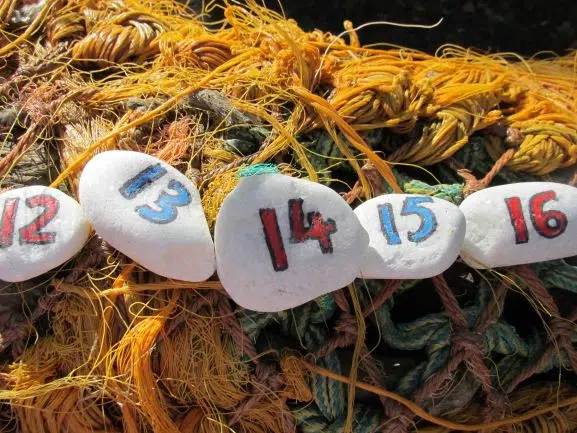
Ordering Numbers – Ascending
The simplest way to start with ordering numbers is to teach how to sequence them in an ascending order.
In simple talk, this basically means putting them in the right order – 1, 2, 3, 4, 5…etc.
The numbers are getting bigger, and so ‘ascending’. It is like going ‘upwards’.
However, this is not the only way numbers can be put in ascending order.
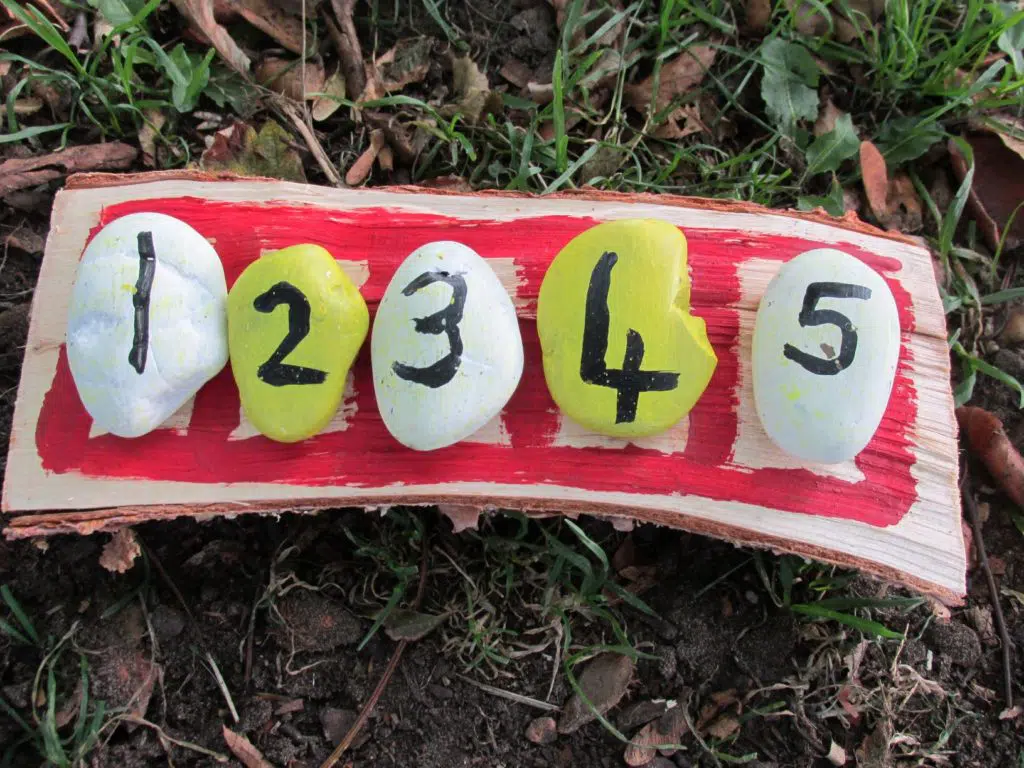
Other different methods of ascending number orders:
• The numbers ascending and going up in 1s, but not starting from 1. An example would be 5, 6, 7, 8, 9.
• A selection of numbers that are not in a sequence of going up in 1s, put in ascending order. For example, the numbers 6, 3, 17, 14 could be put in ascending order like this: 3, 6, 14, 17.
• You can have an ascending order of numbers in the multiplication table, e.g. 10, 20, 30, 40, 50. Or it could be 2, 4, 6, 8…
For children, the above are the most common types of ascending orders of numbers. Now let’s go on to descending…
Descending
Putting numbers in order this way is the opposite of ascending order, and it’s called descending order. Descending is like ‘going down’. The most common ways of creating descending orders of numbers are:
• Starting from a number and going backwards. The most common is like a countdown for a spaceship – 5, 4, 3, 2, 1, 0.
• The same as above, but not going to 0 – e.g. 8, 7, 6, 5, 4.
• A selection of random numbers that are decreasing – e.g. 9, 6, 5, 2.
• A times table in decreasing order – 60, 50, 40, 30, 20, 10, 0.
Right, now let’s go on to a really important bit, which is what order should you teach ordering numbers.
What Comes Before Ordering Numbers
Now to the real nitty-gritty: how to actually teach ordering numbers to children.
The really important thing is that children need a few basic skills before they will be able to put numbers in the correct order so it is important to expose them to some of the following things first like…
1. Ordering Through Size
This is definitely easier than ordering numbers and is something children will experience through play from a younger age. Besides, comparing and ordering are quite similar. For instance, comparing sizes and ordering them is just like comparing numbers and ordering them in the correct order–from highest to lowest or vice versa (ascending or descending order).
Some good activities for them to try include:
- Hanging differently sized clothes up on a washing line. I like to use the ‘giant’s clothes’ (normal adult clothes) and baby clothes.
- Comparing values or weighing things either outdoors or in. Some examples could be, trying to find the heaviest stick or stone.
- Playdough ordering through length. Children make models and order them. Some good examples are snakes, magic wands, worms, or broom-sticks. This is one of the ideas in my article 15 playdough maths games.
- Talking in a play about which is heavier/lighter, longer/shorter.
2. Counting Songs
There are many songs that include sequences of numbers, and these are good for getting children to memorize sequences in a fun and multisensory way.
Good songs include:
1, 2, 3, 4, 5 Once I Caught A Fish Alive – an ascending number sequence
The lyrics in full go:
1, 2, 3, 4, 5 once I caught a fish alive
6, 7, 8, 9, 10 then I let it go again.
Why did you let it go?
Because it bit my finger so!
Which finger did it bite?
This little finger on my right!
There are surprisingly few counting songs that actually go forwards. The vast majority involved counting backwards for some reason.
There are quite a few songs that involve a descending sequence of numbers.
Probably my favorite one is the Zoom Zoom Zoom song. This is a rocket-launch song. You stand in a circle and sing:
Zoom zoom zoom
We’re going to the moon!
Zoom zoom zoom
We’ll be there very soon!
10, 9, 8, 7, 6, 5, 4, 3, 2, 1, 0. Blast Off!
This is brilliantly done with a parachute. The children stand around the chute and gently lift it up and down to the beat as they sing the song.
Then shake the chute for every number of the countdown, and when you get to the blast off everyone lifts the parachute quickly into the air and lets go! If you do it right, the parachute will soar into the air and stick briefly to the ceiling.
This is just one of the activities involved in my post The Greatest 40 Parachute Games For Kids that you can check out here.
3. Practicing Rote Counting
This is really important. Before children can realistically start to order numbers, they need to be able to confidently say them in order.
The simplest way to rote count is starting with 1 and going upwards – 1, 2, 3, 4, 5. However, there are all sorts of ways to rote count, and practicing this before going on to order numbers in that way is definitely the way to go.
Some great games to practice rote counting include:
- Dance counting – put music on and chant the numbers to the beat whilst doing dance moves
- March counting – march and count!
- Say the numbers with a puppet
- Buddy Count – face a partner, one person says ‘one’, the next ‘two’ and keep going!
These are just a few good examples of how to rote count. I really would recommend that you check out my article 17 Fantastic Ways To Teach Rote Counting.
4. Recognizing Numbers
It is pretty much essential to recognize numbers first, and order them second.
Some good ways to help children recognize and compare numbers include:
- Sky-writing the numbers in the air with ribbons or streamers
- Practicing drawing them in ‘fun’ substances like shaving foam
- Games with number dice
- Introducing them with stories
- Show the numbers whilst singing number songs
I have written the definitive guide to how to teach recognizing numbers (with 16 games) that you can check out here.
The Process Of Teaching Ordering Numbers
If children are ready and have the skills outlined above, then there is a definite process and a sequence that it is a good idea to follow to help them learn the different ways of ordering numbers.
It is a seven-step process and goes like this:
- Start with putting numbers in order from 1, e.g. 1, 2, 3, 4…
- Next is to try to order a few numbers that are not next to each other on a normal number line, e.g. 2, 5, 9, 10
- Order numbers in a sequence, but not starting from 1, e.g. 3, 4, 5, 6, 7
- Order numbers in decreasing order, e.g. 5, 4, 3, 2, 1, 0
- Order random selection of numbers in decreasing order, e.g. 9, 6, 4, 3
- Order numbers in a times table, e.g. 10, 20, 30, 40
- Order numbers in descending order in a times table that they know, e.g. 8, 6, 4, 2, 0
But how do you start teaching ordering numbers – ascending order to descending order (or vice versa)?
How To Teach Ordering Numbers – 11 Games
There are some excellent ways to start children off with ordering numbers that include:
1. Using A Counting Stick
This is my number one way to start them off.
I use a broomstick with Velcro pieces stuck on it. I then place the numbers on the Velcro sections.
Start simple – probably just with the numbers 1 to 5. I’d only mix up two numbers, and then see if they can put them back in the right order.
Next steps include:
- Mix up more numbers
- Use numbers 1-10
- Use a random selection of numbers
- Use numbers in 10s, 2s or 5s
For a full look at different maths games you can do on a counting stick then check this out.
2. Group Ordering
They really enjoy this. Get a group of children (probably no more than 5 to start with) to all hold a separate number card (of the numbers 1-5 to begin with). They try to compare numbers and put themselves in order.
3. Toys Or Objects With Numbers On
Make it into a fun story or a game. Have some kind of objects with numbers on them.
Also, have a magic chest or box that is closed. Get the numbers in order, and we can open the magic chest, and there will be something exciting inside!
4. Using a Number Line
A number line can help children visualize the numbers and better understand how to order them.
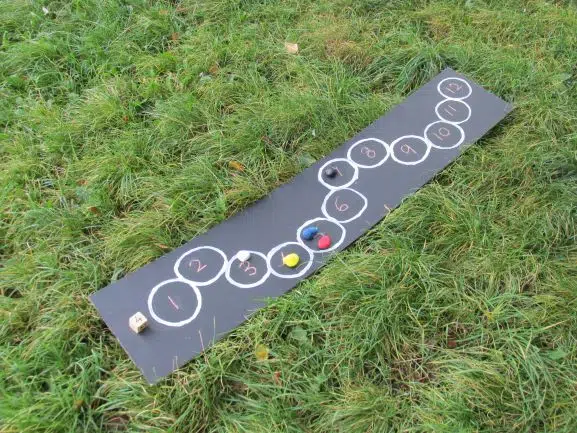
There are many ways of beginning to order with number lines including:
- Games like hopscotch
- Number lines on the floor outside for games like roll a dice and jump that number
- Number lines with missing numbers
- Blank number lines. Use objects such as stones or shells with numbers on them to put in order on the number line.
5. Containers With Numbers On
There are so many things that you can put numbers on and then try to put them in order.
It really helps the experience if the children fill them up with something as well – this matching numeral to quantity can help with the understanding of ordering.
Some great items to put numbers on include:
• Plant pots
• Shot glasses
• Egg cups
• Plastic cups
• Small boxes
• In a muffin tray
To fill them, use something like stones, or pompoms, or beans.
For example, fill up some shot glasses with the right number of items and then put them in order.
You can really see the numbers getting bigger, as the quantities of pompoms increase. For example, one pompom looks like a small number. Five pompoms in the container look much larger.

6. Ordering With A Puppet
Puppets invoke a kind of magic spell on many children. There are lots of kids who struggle to listen to adults, but the same children are captivated when a puppet comes out!
You can order with puppets in several ways. A great technique is for the puppet to be really bad at something, and the children try to help it.
For example, a puppet might have 5 plant pots with numbers on them. It tries to put them in order but goes 1, 2, 5, 4, 3. Is that right!?
The children love helping the puppet and coaching it to success!
Any puppet would work for this. You could even use a teddy, or a toy, or maybe a finger puppet.
7. Washing Lines
Washing lines are one of the ultimate resources for early maths.
You can do ordering in a range of ways.
You can get some number cards and get children to peg them onto the line in different ways to order.
An even easier strategy is to use pieces of card that are bent over into a ‘v’ shape. These are simple for children even those who have fine motor difficulties to put onto the line with little hassle, as some have big problems trying to peg things on.
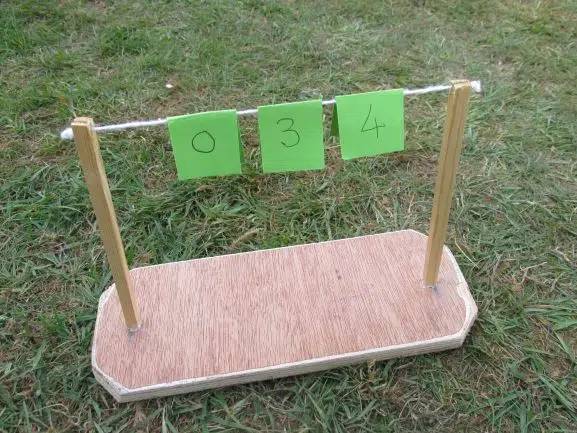
On these pieces of card, you can have some numbers. Of course, you could have:
• The numbers from 1-5, or 0-10 (or beyond)
• Have a random array of numbers (e.g. 3, 7, 8 and 10) that could be put in either ascending or descending order
• You could have numbers from a times table (e.g. 2s or 10s) that again could be put either going up and going down
When children are starting off, it is often wise to have a number line that they can refer to. Later on, they will probably be able to order without a visual aid such as this.
8. Number Stones
Natural and interesting resources are always a great option for teaching most skills.
If you can fire children’s curiosity, then they usually become much more fully engaged in what they are doing.
These number stones are great for this.
They are simple to make, and once made will last a lifetime.
Get some stones and simply draw or paint some numbers onto them. The ones I have made are like a repeating pattern also – they go yellow, white, yellow, white if they are put in order. This is optional! However, it is good for an introduction to odd and even numbers, and great for seeing patterns in number sequences.
You can put the stones in a line, or you can put them on something like a plank number line. I have made these ones that have curtain hooks superglued to planks:
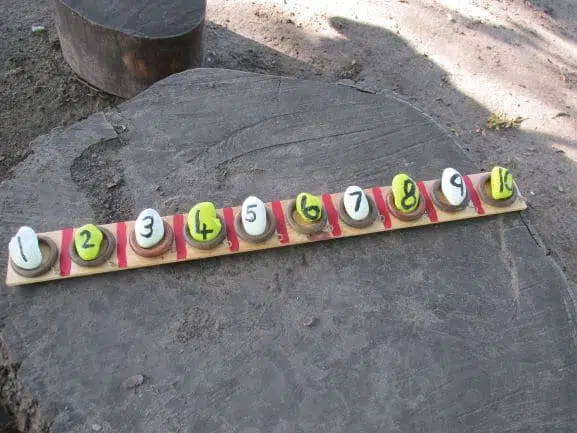
These are excellent for ordering things such as number stones.
I have different types of number stones, that are all great for ordering, including:
• 10s stones – e.g. 10, 20, 30 etc
• Numerals stones – 1 – 20
• Stones with quantities on – 1-10
All these are great for a wealth of ordering experiences.
9. Secret Code!
Most children love anything to do with superheroes or top-secret spies.
So why not include secret codes where ordering numbers are concerned?
You could do this in many ways, but one way could be the following:
Have some stepping stones (maybe rubber spots) with numbers on them. Also, have a secret box with something hidden inside. The children must put the stepping stones in order on the floor leading to the box.
If they get the order right they have broken the secret code, and can peek inside the box!
Once again, this could be extended to having different types of number sequences as the secret code that they need to break.
10. Golf!
Sports are very exciting for many children, and the more you can include them in what you do the better!
Golf is a great example of this.
One simple way to play it is to draw huge circles on the floor outside in chalk. These circles are the golf ‘holes’. Put big numbers in them as well (whatever numbers you want to order).
Then use something like a big sponge ball and something to hit it with (it could be a small plank, or your foot). Try to get the ball into the ‘hole’.
For ordering you can go in order around the golf-hole. Start at one, and go onto two etc. Or, if you’re doing it tens, start at ten then go onto twenty, and keep going.
Golf can be done in a similar way but on a smaller scale inside. For example, you can use lolly (popsicle) sticks for the golf clubs, and a pom-pom for the ball. Draw the golf course on a big piece of paper on the floor.
11. Treasure Hunts!
For a treasure hunt, you make some kind of clues or secret code, but the children have got to find it in the right order!
For example, have the first clue with the number ‘1’ on it. The clue will lead them to clue number ‘2’ and so on.
At some point, they will have found the ‘treasure’ (whatever that is).
The clues could be:
• A picture of where the next clue can be found
• A short sentence for reading children, such as ‘go to the sink.’
Top Tips For Ordering Numbers
- Before they can order numbers, children should be allowed to order through size, length and weight
- Children require exposure to number lines to visualize sequences of numbers
- Help them to understand how numbers increase and decrease in size through a play-based curriculum, where they can visualize matching numerals to quantity
- Practice the skill with rote counting games
- Move in order through the 7-step sequence
- Link it to life and make it practical
Conclusion
Ordering numbers brings a lot of skills together. By regularly working on recognizing numbers, rote counting, and matching numerals to quantity, children will pick up the skills required for ordering and start to apply them. Besides it’s a skill that will be even more crucial in their daily lives as adults.
If you have found this article useful, then why not check out one of these:
